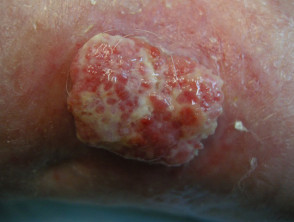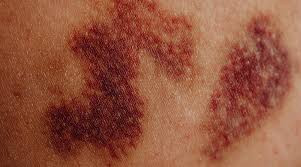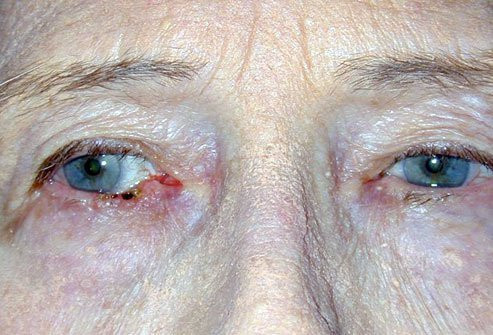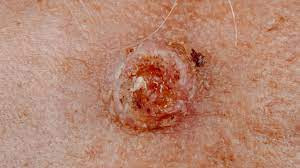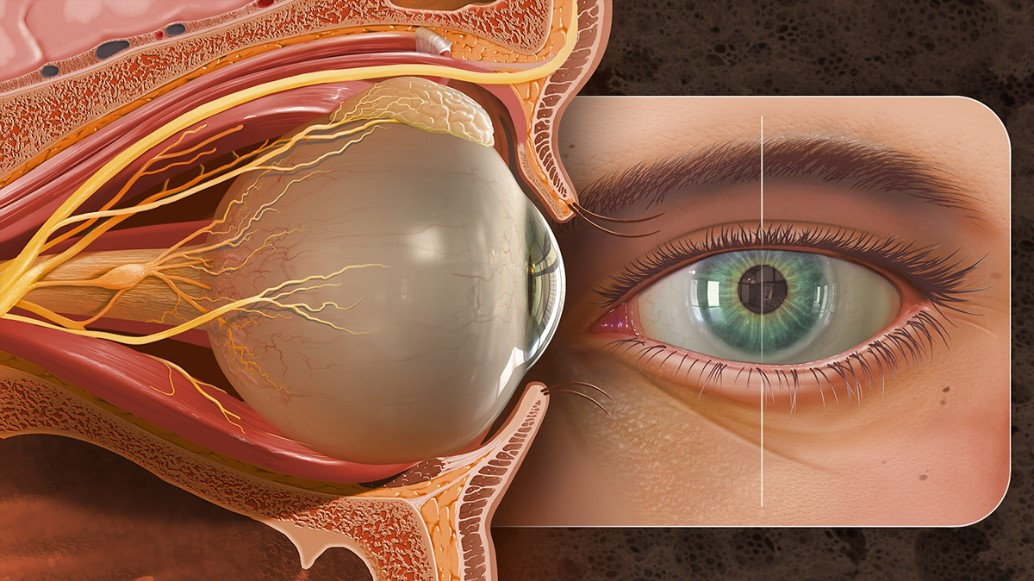Definisi
Kanker kulit merupakan pertumbuhan sel kulit yang tidak normal, dan merupakan salah satu jenis kanker yang paling banyak ditemukan di dunia. Kanker bukan merupakan penyakit menular. Terdapat banyak jenis kanker kulit selain melanoma yang akan dibahas di dalam artikel ini, yaitu karsinoma sel basal dan karsinoma sel skuamosa. Jenis kanker kulit dibedakan dari sel yang menjadi asal mula kanker tersebut berkembang.
Penyebab
Kanker kulit terjadi karena adanya kelainan atau mutasi DNA genetik dari sel kulit. Normalnya, sel memiliki masa hidup yang tetap dan akan mati pada waktunya, untuk diganti dengan sel baru. Kelainan ini akan membuat sel kulit untuk terus berkembang secara tidak terkontrol dan tidak mati. Umumnya kanker kulit mulai muncul di lapisan atas kulit, yaitu epidermis. Lapisan teratas kulit ini terdiri dari tiga sel utama, sel skuamosa, sel basal, dan melanosit yang memproduksi melanin (pigmen yang memberi warna kulit). Jenis kanker berbeda tergantung dari salah satu jenis sel kulit yang bermutasi.
Umumnya kerusakan DNA sel kulit disebabkan oleh radiasi sinar ultraviolet (UV) dari paparan sinar matahari dan cahaya yang dipancarkan mesin tanning. Namun, teori ini tidak dapat menjelaskan mengapa kanker kulit juga dapat timbul di area yang tidak terpapar matahari. Oleh karena itu, masih banyak faktor lain yang dapat memicu kanker kulit, seperti terpapar dengan bahan beracun atau adanya kondisi pada pasien yang menurunkan sistem kekebalan tubuhnya.
Faktor Risiko
Faktor yang meningkatkan risiko terkena kanker kulit adalah:
1. Kulit Putih
Meskipun semua orang dengan warna kulit apapun dapat terkena kanker kulit, namun orang berkulit putih memiliki pigmen kulit yang lebih sedikit. Pigmen tersebut berfungsi untuk melindungi kulit dari radiasi sinar UV yang merusak, sehingga mereka lebih rentan terkena kanker kulit. Orang yang memiliki rambut dan iris mata yang berwarna terang, mudah timbul freckles atau bintik-bintik di wajah, dan mudah terbakar sinar matahari juga lebih berisiko terkena kanker kulit.
2. Riwayat Terbakar Sinar Matahari
Jika Anda sering berjemur di bawah sinar matahari atau pernah terbakar sinar matahari sampai timbul lepuhan pada kulit, maka Anda berisiko lebih tinggi untuk terkena sinar matahari. Orang yang sering menghabiskan waktu di bawah sinar matahari dapat terkena kanker kulit, terutama jika tidak memakai tabir surya. Tanning juga berisiko karena memancarkan sinar UV.
3. Tinggal di Daerah Beriklim Panas atau Dataran Tinggi
Orang yang tinggal di daerah yang beriklim panas akan terpapar matahari lebih banyak daripada orang yang tinggal di iklim dingin. Selain itu, pada dataran tinggi, sinar matahari lebih kuat dan lebih memancarkan radiasi.
4. Tahi Lalat
Orang yang memiliki banyak tahi lalat atau memiliki tahi lalat yang abnormal lebih berisiko untuk kanker kulit. Tahi lalat yang abnormal adalah yang berbentuk tidak rata, berukuran lebih besar dari tahi lalat kebanyakan. Tahi lalat seperti ini lebih mungkin untuk mengalami perubahan menjadi kanker. Jika Anda memiliki tahi lalat seperti ini, perhatikan bentuknya dari waktu ke waktu
5. Riwayat Keluarga
Jika salah satu orang tua atau saudara kandung Anda memiliki kanker kulit, maka risiko Anda untuk terkena kanker kulit menjadi lebih tinggi. Bila Anda pernah menderita kanker kulit, risiko Anda untuk mengalami kanker kulit lagi akan meningkat.
6. Kondisi Kesehatan Lainnya
Gangguan sistem kekebalan tubuh yang diakibatkan misalnya oleh HIV/AIDS atau konsumsi obat penekan sistem imun, biasanya setelah transplantasi organ, dapat meningkatkan risiko Anda terkena kanker kulit. Kondisi kulit prekanker juga berisiko tinggi untuk berkembang menjadi kanker.
7. Paparan Zat
Paparan zat tertentu seperti arsen atau menerima terapi radiasi untuk kondisi kulitnya, dapat meningkatkan risiko kanker kulit, terutama karsinoma sel basal.
Gejala
Kanker kulit sering timbul pada area kulit yang terpapar matahari. Namun, area kulit lain yang biasanya tidak terpapar matahari juga dapat terkena, misalnya telapak tangan, bagian bawah kuku, jari kaki, dan area kemaluan. Terdapat dua jenis kanker kulit selain melanoma yang akan dibahas dalam artikel ini.
Karsinoma Sel Basal
Kanker ini berasal dari sel basal kulit, yang berperan untuk memproduksi sel kulit baru dan mengangkat sel kulit yang sudah tua ke permukaan kulit. Kanker ini bisa tumbul di area kulit mana saja, namun sering ditemukan pada kepala, leher, dan lengan. Jenis kanker ini paling sering muncul pada orang-orang yang berkulit putih. Pada kanker ini, bisa dilihat:
- Benjolan kecil yang terlihat berkilau, tampak seperti daging yang berwarna kecoklatan
- Terkadang ada bercak yang berwarna coklat atau kehitaman
- Benjolan bisa membesar seiring waktu dan dapat mengelupas atau mudah berdarah
Karsinoma Sel Skuamosa
Sesuai namanya, kanker ini berasal dari sel skuamosa kulit. Bila sel basal terletak di bagian bawah epidermis (lapisan teratas kulit), maka sel skuamosa berada di lapisan atas epidermis. Sel skuamosa membentuk permukaan kulit dan rutin diganti seiring pembentukan sel baru. Kanker ini paling banyak timbul di area kulit yang paling sering terpapar sinar matahari seperti wajah, telinga, punggung, dada dan tangan. Pada orang yang berkulit gelap, dapat mengalami karsinoma sel skuamosa pada bagian tubuh yang tidak sering terpapar matahari. Bentuk kanker ini adalah:
- Benjolan kecil yang padat dan berwarna merah
- Permukaan benjolan bersisik atau kasar
- Benjolan terasa nyeri saat ditekan dan mudah berdarah
Kanker Kulit Lainnya
Terdapat jenis kanker kulit lainnya walaupun cukup jarang ditemukan, antara lain:
- Kaposi sarkoma, kanker kulit tipe ini termasuk jarang dan merupakan kanker pada pembuluh darah kulit sehingga menyebabkan bercak merah pada kulit atau selaput lendir, biasanya timbul pada orang-orang dengan sistem kekebalan tubuh yang rendah
- Karsinoma sel merkel, ada benjolan kecil yang padat dan mengkilap yang timbul di atas atau sedikit dibawah kulit dan pada folikel rambut, paling sering timbul di kepala, leher, dan badan
- Karsinoma kelenjar minyak, walaupun jarang ditemukan namun kanker ini bersifat agresif, biasanya berbentuk benjolan kecil yang keras, tidak nyeri, dan dapat timbul dimana saja, namun paling sering di kelopak mata
Diagnosa
Untuk mendiagnosa kanker kulit, dokter akan bertanya mengenai keluhan Anda, riwayat penyakit Anda dan bila ada riwayat kanker kulit pada keluarga. Dokter juga akan bertanya mengenai pertumbuhan benjolan atau kelainan kulit yang Anda rasakan. Setelah itu, dokter akan melakukan pemeriksaan pada kulit Anda.
Jika dokter mencurigai adanya kanker, maka akan dilakukan pengambilan sampel dari area kulit yang mengalami kelainan untuk dilakukan pemeriksaan (biopsi). Dari pemeriksaan biopsi, dapat dilihat apakah perubahan atau kelainan di kulit Anda merupakan kanker atau tidak.
Tata Laksana
Pilihan terapi kanker kulit bervariasi tergantung ukuran, tipe, kedalaman, dan lokasi kanker. Kanker yang berukuran kecil dan terbatas hanya pada permukaan kulit mungkin bisa dilakukan prosedur pengangkatan benjolan. Namun, pada kondisi tertentu, diperlukan terapi tambahan untuk mengobati kanker.
Terdapat beragam prosedur bedah yang akan disampaikan oleh dokter pada Anda. Tidak hanya itu, dokter juga dapat memberikan pilihan terapi seperti:
- Terapi radiasi, menggunakan radiasi tinggi seperti sinar x-ray
- Kemoterapi yang menggunakan obat-obatan untuk membunuh sel kanker
- Terapi fotodinamik, menggunakan kombinasi cahaya laser dan obat yang membuat sel kanker lebih sensitif terhadap cahaya
- Terapi biologis, menggunakan sistem kekebalan tubuh untuk membunuh sel kanker
Komplikasi
Kanker kulit dapat menyebabkan kerusakan jaringan sekitar tempat tumbuhnya dan dapat menyebar ke organ lain di dalam tubuh. Selain itu, bila sebelumnya Anda pernah mengalami kanker kulit, ada kemungkinan kanker akan muncul kembali di kemudian hari, yang bisa berukuran lebih besar dengan gejala lebih berat. Oleh karena itu, Anda mungkin perlu melakukan check up secara rutin untuk memonitor kesehatan Anda.
Pencegahan
Anda dapat menngurangi risiko terkena kanker kulit dengan:
- Membatasi atau menghindari paparan radiasi sinar UV terutama pada siang hari
- Rutin memakai tabir surya
- Memakai pakaian yang melindungi kulit dari sinar UV
- Hindari tanning
- Hati-hati dalam penggunaan obat-obatan yang menyebabkan kulit menjadi lebih sensitif terhadap sinar matahari
- Periksakan kulit jika terdapat perubahan yang mencurigakan pada kulit
Kapan Harus ke Dokter?
Anda disarankan berkonsultasi ke dokter jika Anda menyadari adanya perubahan pada kulit yang mengkhawatirkan Anda. Namun, tidak semua perubahan pada kulti merupakan pertanda kanker kulit. Dokter akan melakukan pemeriksaan untuk menentukan sebabnya.
Mau tahu informasi seputar penyakit lainnya, cek di sini ya!
- dr Hanifa Rahma
Skin cancer: diagnosis and treatment, Mayo Clinic. Mayoclinic.org. (2022). Retrieved March 24, 2022, from https://www.mayoclinic.org/diseases-conditions/skin-cancer/diagnosis-treatment/drc-20377608.
Non-melanoma skin cancer. nhs.uk. (2022). Retrieved March 24, 2022, from https://www.nhs.uk/conditions/non-melanoma-skin-cancer/.
Types of skin cancer. Aad.org. (2022). Retrieved March 24, 2022, from https://www.aad.org/public/diseases/skin-cancer/types/common.


